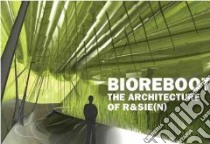Bioreboot - 9781568988696
Un libro in lingua di Giovanni Corbellini edito da Chronicle Books Llc, 2010
- € 39.10
- Il prezzo è variabile in funzione del cambio della valuta d’origine
What do you call an architecture firm that draws inspiration from the most extreme aspects of nature and human psychology? When faced with this challenge in 1989, architect François Roche decided that the best way to express his firm's design philosophy would be to change its name every few years. Presently, the Paris-based practice goes by the name of R&Sie(n). Pronounced 'heresy' in French, the firm's radical approach—what they refer to as a 'chameleon strategy'—permeates everything they do, right down to their gender-bending, morphed anti publicity photo. Led by Roche, R&Sie(n)'s investigative approach to architecture focuses on developing technological experiments—cartographic distortions and territorial mutations—in order to explore the bond between building, context, and human relations. Each building is a process, a dynamic device with the tenacity of a parasite that uses every means offered by architecture to perform an ecologically useful function.
Bioreboot features nineteen projects—illustrated with extensive plans, photographs, and renderings—along with essays and interviews, providing the most comprehensive monograph of this elusive, intriguing firm to date. Despite working with oppositional relationships—machinery versus nature, purity versus corruption, paranoia versus rationality—theirs is an architecture whose primary aim is the ecological and social improvement of the place in which it exists. The 2003 Mosquito Bottleneck project mixes objective paranoia with a desire for safety. Designed as a trap for dangerous, West Nile Fever-infected mosquitos, the intestinelike private home in Trinidad weaves together all of its surfaces—floor, facade, and roof—with plastic wire and shrink-wrap. (Un)Plug, a speculative skyscraper project commissioned in 2000 by the Parisian electricity company EDF, features a glass facade of swelling, photoelectric pustules that allow the building to gain enough solar energy to disconnect from the urban energy grid. Bioreboot is a thought-provoking leap into the future and a clarion call for the development of a new relationship between contemporary architecture and the world of nature.
Informazioni bibliografiche
- Titolo del Libro in lingua: Bioreboot
- Sottotitolo: The Architecture of R & Sie
- Lingua: English
- Autore: Giovanni Corbellini
- Editore: Chronicle Books Llc
- Collana: Chronicle Books Llc (Paperback)
- Data di Pubblicazione: 03 Febbraio '10
- Genere: ARCHITECTURE
- Argomento: Architecture and biology
- Pagine: 223
- Dimensioni mm: 234 x 158 x 19
- ISBN-10: 1568988699
- EAN-13: 9781568988696


